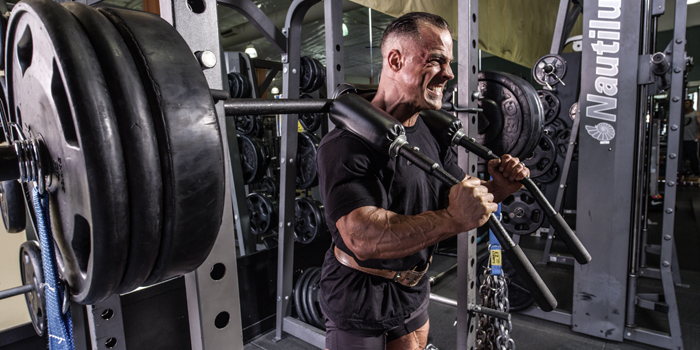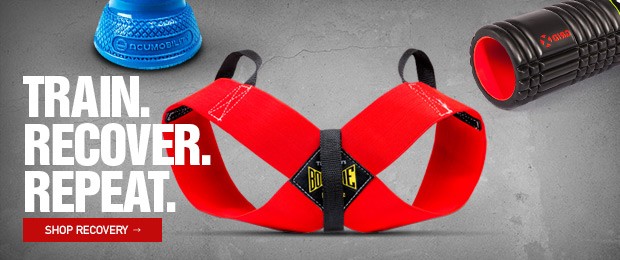
When strength and power are your priority, often you put the need for mobility and stability prep in the backseat. There is nothing wrong with that unless it’s inhibiting you from being as strong and as powerful as you could be. Often, skimping on movement prep is just pure laziness. Let’s be honest, jamming a few doughnuts down your gullet, chugging a couple Rockstar energy drinks, and shooting the shit before you jump right under the bar sounds a lot more appealing than crawling down into a 90/90 position for internal and external hip mobility.
In some cases, it’s a lack of education. What mobility or stability drills should I do? How much should I do of them? Which days do I do them on? Powerlifting and bodybuilding usually come secondary to work, life, relationships, etc., so mobility and stability exercises are often left out due to time constraints.
RECENT: Rehab Done Right: 7 Mistakes of Injury Rehabilitation
In this article, I’m going to keep it simple for you. Here’s what to do, when to do it, how to do it, and how long you should do it for. This will benefit anyone looking to introduce mobility and stability into their training, and will especially benefit powerlifters and bodybuilders, as the stability exercise and drills will address common dysfunctions associated with both.
Powerlifters, these can be done on any lower body training day but will greatly benefit as a squat and deadlift prep due to the emphasis on glute rotation and activation, anterior core stability, and unilateral leg/adductor mobilization. For bodybuilders and physique athletes, this should be done in addition to and prior to your lower body training days due to the common muscular imbalances of the quads to hamstring/adductors. Here are three things you should be doing every lower body day to correct this, in order.
90/90 Breathing with Internal Rotation (IR)
Many athletes who powerlift and bodybuild have issues with internal rotation and adductor activation (unless sumo pulling) due to quadriceps and hamstring/adductor imbalances. This often leads to a larger-than-desired external rotation of the femur and foot. It may present itself as an inability to properly maintain good foot position and a neutral pelvis. This ends up throwing you into extension, making you look like you’re nine months pregnant. In this position, I often see an overuse of the tensor fasciae latae (TFL) for hip flexion and extension and inability to properly use glutes. Instead, you use your erectors for extension and hamstring flexion. This leads to the ever-so-popular powerlifter and bodybuilder waddle.
Check out the breathing and mobility drill below that puts emphasis on maintaining a neutral pelvis, diaphragmatic breathing, internal rotation of the hips, and ramping down the sympathetic nervous system. It will lead to a more desired state when ready to load the bar for heavy squats or deadlifts. This drill will help decrease the tone in the erectors and decrease your mid-session back pump where you’re keeled over a chair because you can barely walk and breathe. I’d bet it would feel nice to be able to catch some air without having to cough up a lung.
Points of emphasis:
- Maintain neutral pelvis by slightly posteriorly tucking your pelvis (tucking your tailbone).
- Maintain good alignment between your pelvis and ribcage, keeping your low back in contact with the floor.
- Breathe into our stomach via inhalation through your nose and exhale through your mouth forcefully. This full expiration yields internal and external oblique activity as well as transverse abdominis activation.
- Drive knees together against a pillow or foam roller while maintaining the above.
- Make sure your foot (this includes your heel, big toe, and pinky toe) remains in contact with the wall the whole time.
- Complete for one to three minutes.
Single-Leg Windmill
Much of the lower body training for powerlifting and bodybuilding consists of hip and knee extension in the sagittal plane (up and down movements). The movement that is often missing is glute rotation and hip rotation in the transverse plane (left to right). This creates compensations when it comes to static posture and when initiating movements. Much of the needed power and strength that comes from the core lies within the transverse plane, and if it can't be moved it can't be used. This movement/stability drill (can be classified as both due to the stability factor) emphasizes glute activation in the rotational/transverse plane, hip and knee disassociation for increased stability and activation, medial longitudinal arch stability, thoracic rotation, and adductor mobilization.
Points of emphasis:
- Maintain neutral pelvis and avoid thoracic or lumbar extension.
- Do not make this movement about stability or balance until you've mastered the basics.
- Hold onto something if stability and balance continue to be an issue.
- Maintain proper alignment between ribcage and pelvis.
- Initiate rotation from hip and ipsilateral shoulder.
- Drive knee and hip in opposite directions.
- Maintain medial foot arch and avoid collapsing.
- Breathe throughout the movement (diaphragmatic breathing).
90/90 Seated Hip Internal Rotation and External Rotation
By now I hope you can see a pattern developing. If not, I’ll make it real clear for you. Powerlifters and bodybuilders have some of the worse hip mobility, especially at the end ranges, because of their dominant flexion and extension movement patterns. However, this is a necessity in specificity of sport training. Sports demand a need for specific training, but too much of anything can become a bad thing. Getting into this position will reveal a lot about a person’s mobility and stability. Your focus here should be to maintain an upright torso while mobilizing into internal and external hip rotation. For a lot of you, this will be difficult at first and you will be falling over like a newborn baby fawn. Post yourself up and focus on mobilizing the joint and tissue first, and as it becomes easier begin to add the stability demands of an upright torso. There is no wrong or right way when beginning this drill, just get into the corners that are uncomfortable and work. I do recommend working the internal hip (back trailing leg) first.
Points of emphasis:
- Keep all lower body joints at 90 degrees.
- Maintain a stacked torso: head, ribcage, lumbar all in line.
- Use glutes and pelvic posterior rotation to drive internal hip into a deeper stretch.
- Use diaphragmatic breathing to increase internal pressure and create space.
- For your external hip (front leg) the same principles apply as above, but we are going to contract/relax into the mobilization to increase our range of motion.
- Maintain stiffness in the entire body when driving the front leg into the ground and contract your glute. After relaxing, pull yourself down until you reach a new barrier.
- Hold each barrier for one to two minutes followed by a 10- to 20-second contraction, then find a new barrier and complete for up to three rounds.
There you have it, three simple mobility and stability drills that you can perform prior to any lower body day. These address most of the common dysfunctions and compensations associated with powerlifting and bodybuilding.
Keep an eye out for part two, where we focus on the upper body!










